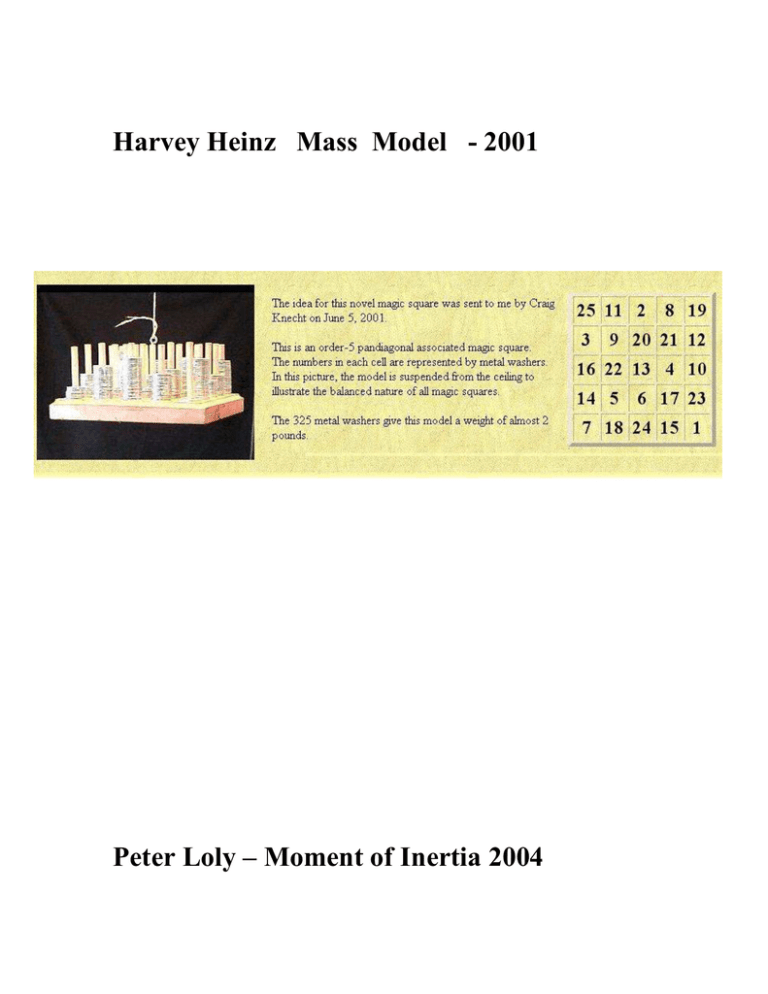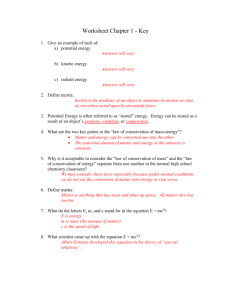Harvey Heinz Mass Model -... Peter Loly – Moment of Inertia 2004
advertisement

Harvey Heinz Mass Model - 2001 Peter Loly – Moment of Inertia 2004 Finding the moment of inertia for the magic square #1. the unit distance between the center of two cells on x/y axis = 1 #2. the entire mass of the cell is presumed to be located at the exact center of the cell #3. the contribution of each cell to the moment of inertia for the square is given by the formula … (distance from center) * (distance from center) * mass of cell #4. the distance from the center of the square is of course found by the illustration below #5. in the above illustration … finding the contribution of cell a1 to the moment of inertia is as follows … a = 2 , b = 2 , c * c = 8 …. Moment of inertia for cell a1 = 8 * (value in cell a1) . figure above illustrates the c * c values for the inner shell figure above illustrates the c * c values for the outer shell Francis Gaspalou March 2008 March 08 GASPALOU’S PROOF Theorem : in a 5x5 magic square - moment of inertia of the inner shell = 195-(center value*3) - moment of inertia of the outer shell = 1105+(center value*3) Note : sum = 1300 (cf. Loly) NOTATIONS The cells of the magic square are called A1 A2 A3 A4 A5 B1 B2 B3 B4 B5 C1 C2 C3 C4 C5 D1 D2 D3 D4 D5 E1 E2 E3 E4 E5 PARAMETERS OF A 5x5 MAGIC SQUARE We can take for example the 14 parameters A, B, D, E, F, G, H, I, K, M, U, V, X, Y. INNER SHELL Moment of inertia = (B3 + D3 + C2 + C4) + (B2 + B4 + D2 + D4)*2 = (2*A + 2*E + M + 2*U + 2*Y - 65) + 2*(130 – A – E – 2*M – U – Y) = 195 – 3*M OUTER SHELL Moment of inertia = (A1 + A5 + E1 + E5)*8 + (A2 + A4 + B1 + B5 + D1 + D5 + E2 + E4)*5 + (A3 + C1 + C5 + E3)*4 = 8*(A + E + U + Y) + 5*(65 + 3*M) + 4*(195 – 2*A - 2*E – 2*U – 2*Y - 3*M) = 1105 + 3*M Walter Trump - March 2008 Moment of Inertia …. Order 7 Magic Square *** Additional notes *** I can’t remember if this came from a subset of order 7 squares . . such as associated/ pandiagonal or such Goofing around …





